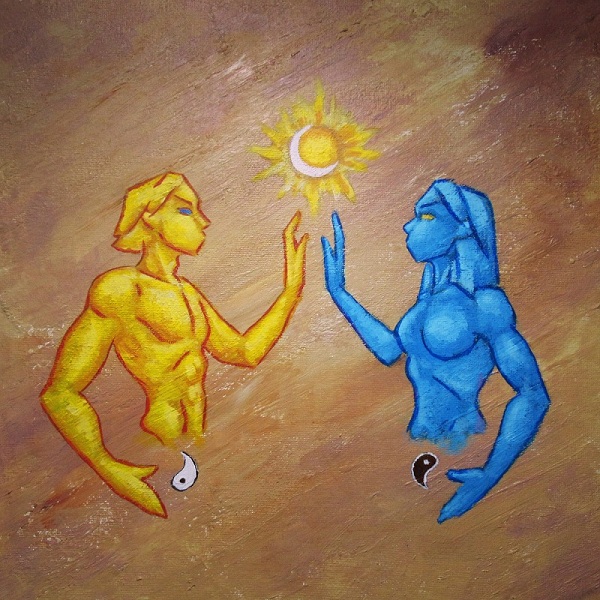Binary Oppositions: Useful Literary Weeds
Illustrated by BRANDY WOODS
Awareness is a fickle thing. We can spend years without taking note of the most obvious things yet lend our attention to the smallest of details. But when a concept is brought to light, given a precise name and a certain set of terms, it becomes legitimate and unavoidable. Suddenly, a mundane detail becomes important, as if highlighted via neon signage.
Most recently this occurred (for me) related in my Literary Criticism class, related to a concept called "Binary Oppositions." Found functioning most commonly in literature, the term refers to a pair of mutually exclusive terms. These terms can come from various sources––cultural, natural or privative (meaning an absence of a certain quality). Those pesky Male/Female, Night/Day, and Heat/Cold divisions? They fall perfectly into the three prescribed Binary Opposition categories.
 One of the most popular Binary Oppositions prevalent in our society is that of the Male/Female division that aims to establish men as the stronger, powerful and overall superior gender while designating the female as a weak, naïve and superficial creature. Our associations with this binary can be seen through the cross-dressing featured most prominently in Shakespeare’s works As You Like It and Twelfth Night, where three female characters adopt male personas as a means to gain power and influence.
One of the most popular Binary Oppositions prevalent in our society is that of the Male/Female division that aims to establish men as the stronger, powerful and overall superior gender while designating the female as a weak, naïve and superficial creature. Our associations with this binary can be seen through the cross-dressing featured most prominently in Shakespeare’s works As You Like It and Twelfth Night, where three female characters adopt male personas as a means to gain power and influence.
The theory of Binary Oppositions may seem to overcomplicate a relatively simple notion––that there are divisions in our thinking about the world––yet it renders itself useful in the analysis of literary works. According to Jonathan Culler, a prominent Structuralist critic, comprehending Binary Oppositions is essential in interpretating literary texts.
A prime example of natural a Binary Opposition that is widely used in popular culture is the Yin Yang symbol, as employed by the practice of the Chinese religion, Daoism. The Yin side (the black side) represents femininity, earth, water and passivity whilst the Yang side (the white portion) is associated with masculinity, sun, fire and aggressive behaviour.
Once these binary oppositions have been discovered in our culture, nearly everything can come to seem part of a pair of Binary Oppositions. Indeed, the theory is oftentimes abused by the student critic, who can become drunk on their newfound power to find/create oppositions in any given text. Literary theory never seemed so unstable and risqué. But despite this danger of abuse, the theory can be immensely useful when engaging in academic writing, as a writer will often unintentionally include a panoply of Binary Oppositions in their text. One major example would be the division between court (town) and country life, a cultural Binary Opposition found in both the works of Shakespeare (most notably in Henry IV, Part 1 and As You Like It) as well as in Leo Tolstoy’s War and Peace.
In War and Peace, there is a strict divide between the posh, upper class world of St Petersburg and the battlefield. Whilst the atmosphere of the soirées is considered to represent the civilised side of the two worlds, it is also perceived as false; all of its participants are seen as mere players, acting out their roles, not expressing any true opinions. Oppositely, the battlefield is truthful; it disrobes the soldiers, the men, of their bravado and all of their pedigree training, making it the ideal of the two.
The theory of Binary Oppositions can help make us aware of the human tendency to rashly assign meaning in oversimplified terms––black and white, us and them––and, at the same time, can help us to complicate those simple oppositions. The more familiar with this theory we become, the more binary oppositions crop up everywhere, becoming as stiflingly apparent and invasive as symbolism in a Nathaniel Hawthorne novel.
However, Binary Oppositions are the weeds of not only of literature but of culture and society in general, revealing a natural human tendency to think in oppositions, a tendency that unintentionally invites itself into the garden of academics studying in mutiple fields.
In terms of applying Binary Oppositions to our day to day, these divisions are plentiful, ranging from North/South and East/West to choosing between black coffee and cafe au lait to the tastes of Salty/Sweet. Without realizing, without being specifically articulated as such, most people's lives, their choices fall between two diametrically opposing elements: Binary Oppositions.
At the foundation of all Binary Oppositions are collisions, a coming together of opposing thoughts that can help reveal new truths about the world, even at the risk of oversimplifying it.

Comments
No comments posted yet.
You have to be registered and logged in in order to post comments!